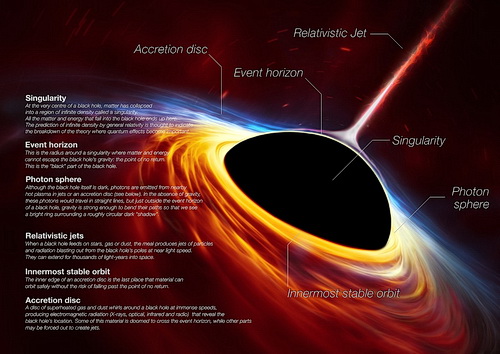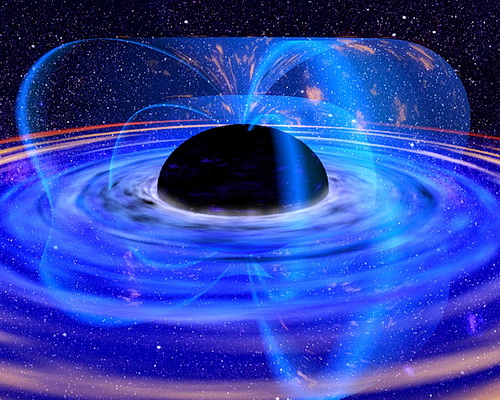
Ever wonder what a black hole is? If I told you that you would be stretched like a rubber band if you came near it, would have I captured your interest?
From planets that orbit around the Sun to galaxies that are bounded by a special force (gravity), the universe is full of surprises and one such surprise is the black hole. These entities have such a high gravitational pull that not even light can escape, which is quite fascinating and mind-boggling in itself.
The existence of black holes was first predicted by Albert Einstein, but the term wasn’t coined with that name until many years later. Initially considered a theoretical object, the first physical black hole was discovered in 1971, but the first-ever image of a black hole was released only this year, which has opened up a new area of study on these magnificent entities. Researchers and astronomers now know what a black hole looks like. But for us, it is important to understand what it is.

First-ever image of a black hole. 53 million light-years from here in the M87 galaxy. Scientists used the Event Horizon Telescope (EHT) which are scores of telescope arrays located in different parts of the world and synchronized to focus on the object on the same day and at the same time.
What Exactly is a Black Hole?
Before we begin, we need to identify two entities. One is matter. The other is gravity. We all know what gravity is, so let’s focus on matter, which is nothing more than an object that is made up of atoms. From the tiniest microorganisms to the largest stars, all objects are made up of matter.
The next factor to note is that all matter has gravity, which is proportional to its size, the larger the object is, the more gravity it will have (we are talking about objects that exist in space, not on Earth).
One example is our planet Earth, which weighs about 13,170,000,000,000,000,000,000,000 pounds (or 5,974,000,000,000,000,000,000,000 kilograms or 5.972 × 10^24 kg ). Yes, that’s a lot but when referring to the size of the universe, it is analogous to a grain of sand on a beach. Its weight (or the amount of matter it contains) is sufficient to have enough gravitational pull to hold the moon in its orbit and revolve around it.
On a grander scale is our Sun, whose gravitational pull keeps the Earth and the other seven planets to revolve around it. If the Sun had no gravity, the Earth (and every other body in our solar system) would be endlessly floating through the universe.
When stars die, they collapse within each other. When our Sun dies, which is expected to happen in about 4.5 billion years, it would collapse into itself, because gravity would be pulling all its mass towards its center. The remains would be a piece of matter about the size of Earth, called a white dwarf.
Since the Sun doesn’t have a sufficient amount of matter/gravity to collapse into itself any further, it will remain as a white dwarf. Another way of describing a white drawf is that its mass may be equal to that of the Sun, but its volume is comparable to that of Earth. This type of event is very common and consists of about 97% of the stars in our Milky Way galaxy.
But What About Larger Stars?
Just think of a star that is massive enough to have such a strong amount of gravity that all its matter gets pulled into the point that it is so much smaller than the Earth-size we mentioned before. As a general reference, let’s say about 18 miles in diameter.
In other words, it is packed so greatly that even though the result is a smaller object, it becomes more dense, because all that matter is condensed within a smaller volume. When this happens, it is called a supernova and results in what astronomers call a neutron star.
You Still Didn’t Explain How a Black Hole is Formed?
Those stars previously mentioned do not have sufficient mass to collapse to the point that they produce a black hole. Now, for stars that are that big,
A black hole is an area in outer space with an exceptionally high gravitational pull. So far, we have predicted the force exerted by the black hole. But it is so strong that even light cannot escape if it goes close to a black hole.
Scientists, however, have understood the reason for such a high gravitational pull. It is because matter has been crammed into a very tiny place. When very huge stars die, they form black holes that continue to absorb all the mass in the surrounding vicinity. Scientists also believe that at times, a single hole can merge with other nearby black holes. It is also hypothesized that the center of any galaxy in outer space is a huge black hole.
Since light cannot escape, we cannot see black holes. They are invisible, but their presence can be felt. NASA has managed to develop special space telescopes that can help locate black holes. These special telescopes can also observe how stars close to black holes behave differently compared to other stars.
Black holes can vary in size. A small black hole can be as small as a single atom, but it can have a mass equivalent to a mountain. So regardless of the size, what makes black holes unique is the mass of matter that is squeezed into them.
Types of Black Holes
Astronomers and researchers have categorized black holes into four types.
Supermassive Black Holes

The first type of black hole is also the largest. This type of black hole has an immeasurable amount of mass. Scientists believe that supermassive black holes are present at the center of galaxies in space. This type of black hole is also found in our solar system and is located at Sagittarius A*.
Intermediate Mass Black Holes
So far, this is a hypothetical type of black hole. The mass in these black holes can range from 100 to 10 hundred thousand solar masses. There is no proof of the existence of this type of black hole. However, there is indirect evidence of the existence of such black holes due to the behavior of certain stars.
Stellar Black Holes
This type of black hole is formed when giant stars collapse. The mass of such black holes ranges from 5 to 100 solar masses. This can be observed as a hypernova explosion or a burst of gamma-ray. This type of black hole is also called collapsars.
Mini Black Holes
This is the last type of black hole. As the name suggests, they are small black holes with less than 5 solar masses. Mini black holes were introduced by Stephen Hawkings in 1971.
Major Black Holes Near Our Galaxy
So far, researchers have spotted three major black holes near our galaxy.
A0620-00
Scientists believe that A0620-00 is a stellar black hole, which is approximately three thousand lightyears away from the Earth. This system of a collapsing binary star belongs to the Monoceros constellation. It comprises an unidentified quantity of solar mass and a star.
Cygnus X-1
Found in the constellation of Cygnus, this black hole was discovered in 1964. This is one of the few black holes which are widely accepted by scientists around the world. It is estimated that this black hole has 15 solar masses and is about 5 million years old. Scientists also believe that it comes from a star that was originally more than 40 solar masses.
V404 Cygni
V404 Cygni is also categorized as a stellar black hole equivalent to 12 solar masses. It also has a star. The star and the black hole orbit within a close range. Because of the proximity of the star to the black hole and the intense gravitational pull, this star continues to lose mass to the black hole.
Beyond Black Holes
There is nothing more mystifying in outer space than black holes. So far, we only know that as we get closer to the edge of the black hole, nothing returns. The gravitational pull is so high that it attracts even the tiniest particles of light. However, we also know that the force is different from suction. So just like something falls on the ground due to gravity, it moves into the black hole due to the same pull.
It is believed that pressure and temperature inside the black holes can be so extreme that it does not support any form of organic life as we know it. Considering life forms that are not organic, we can definitely not comment on that now. No one knows for sure what lies inside the black holes. On one end, there is a galaxy, but what lies on the other side still remains a mystery.
